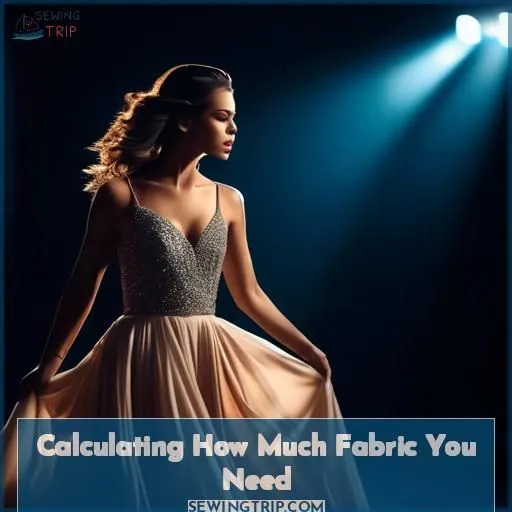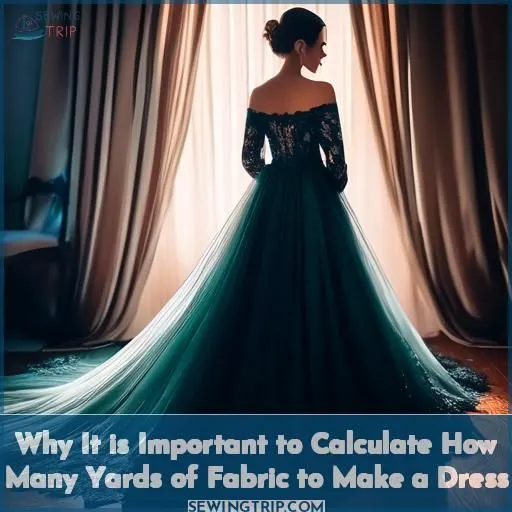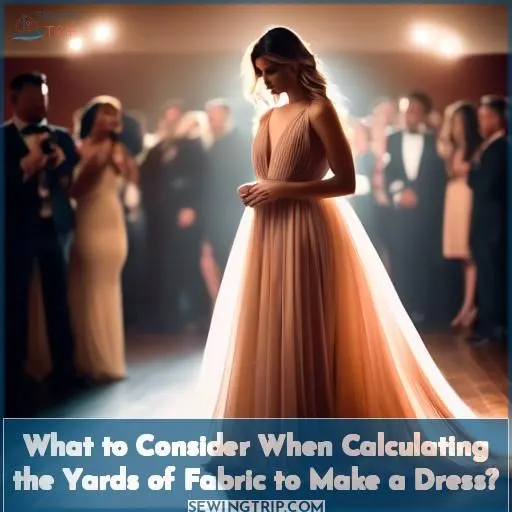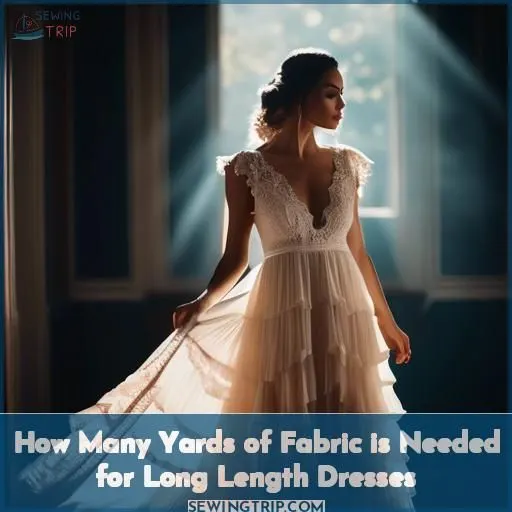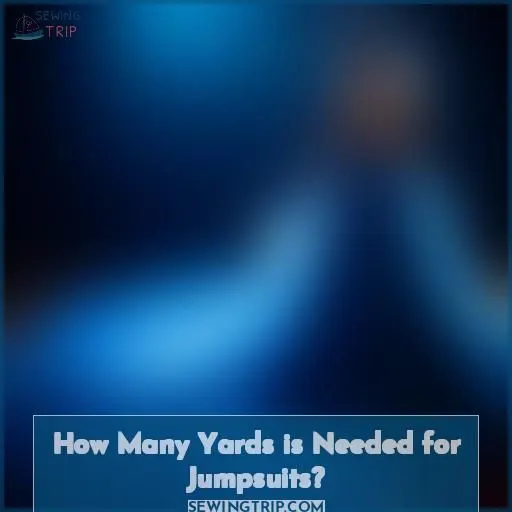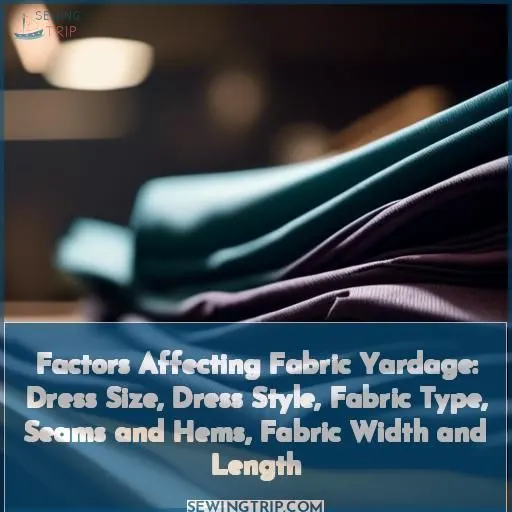This site is supported by our readers. We may earn a commission, at no cost to you, if you purchase through links.
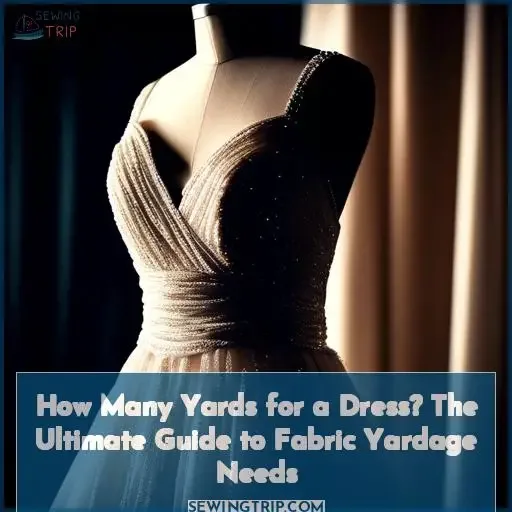
You’ll require 2-2.5 yards for a short dress with short sleeves, and 3-4 yards for long sleeves.
Longer dresses require additional fabric, varying according to style, fabric weight, hem length, seam allowance, and dress length.
The cut and dress style significantly impact yardage – bias cuts use less, while A-line, wrap, and ball gown styles require more.
Patterns affect yardage as well – matching prints and intricate details necessitate sufficient fabric.
Accurate measurements ensure that you purchase precisely the required amount to realize your vision without excessive waste.
Explore further to master the nuances of calculating how many yards for a dress.
Table Of Contents
- Key Takeaways
- How Many Yards for a Dress?
- Calculating How Much Fabric You Need
- Why It is Important to Calculate How Many Yards of Fabric to Make a Dress
- What to Consider When Calculating the Yards of Fabric to Make a Dress?
- How Many Yards is Needed for Short Dresses
- How Many Yards of Fabric is Needed for Long Length Dresses
- How Many Yards is Needed for Jumpsuits?
- Factors Affecting Fabric Yardage: Dress Size, Dress Style, Fabric Type, Seams and Hems, Fabric Width and Length
- Frequently Asked Questions (FAQs)
- Conclusion
Key Takeaways
- The amount of fabric required for a dress depends on factors such as the dress style, fabric type, and body measurements.
- Bias cuts and A-line dresses require different amounts of fabric due to their unique designs.
- Patterns and matching prints can increase the amount of fabric needed for a dress.
- Accurate measurements are crucial for purchasing the correct amount of fabric for a dress project.
How Many Yards for a Dress?
To determine how many yards of fabric are needed for a dress, consider the length, style, and width of the dress. For a short dress with short or capped sleeves, aim for 4 1/4 yards of 35-36 inches wide fabric or 2 3/8 yards of 60 inches wide fabric. For a longer adult-size dress with long sleeves, you will need a minimum of 2 to 3 yards of wide fabric. A full-length ballroom dress typically requires 5 to 7 yards of fabric, while a flared gown needs 6 to 7 yards. It’s essential to consider the pattern and style of the dress, as well as the body measurements, to ensure the correct amount of fabric is purchased.
Calculating How Much Fabric You Need
You’re smart to calculate fabric yardage before starting a sewing project. For a short dress with short or capped sleeves, you’ll generally need around 2-2.5 yards of 45 wide fabric. But patterns, dress style, and your measurements affect the total – bias cuts use less while A-lines need more.
How Many Yards of Fabric for a Short Dress With Short or Capped Sleeves?
Regarding the creation of a brief dress with short or capped sleeves, the fabric quantity required fluctuates depending on variables such as fabric density, sleeve length, dress style, fabric drape, and fabric width.
Typically, a brief dress with short sleeves requires approximately 2 to 3 yards of fabric.
While a brief dress with long sleeves requires 3 to 4 yards.
Keep these variables in mind and adjust accordingly to guarantee the perfect outcome for your dress.
How Many Yards of Fabric for a Long Length Dress?
To make a long length dress, you’ll generally need more fabric than for a short dress. The amount of fabric required can vary depending on the dress style, fabric weight, drape quality, hem length, fabric design, seam width, and jumpsuit length. Here’s a simple guide to help you calculate the fabric yardage needed for a long dress:
- Dress style: The style of the dress, such as A-line, wrap, or ball gown, will affect the amount of fabric needed. For example, an A-line dress will require more fabric than a sheath dress.
- Fabric weight and drape quality: The weight and drape quality of the fabric will also impact the amount of fabric needed. Heavier fabrics and those with more drape will require more yardage than lighter fabrics.
- Hem length: The length of the hem will also affect the amount of fabric needed. A longer hem will require more fabric than a shorter hem.
- Fabric design: The design of the fabric, such as plaids or nap, will also impact the amount of fabric needed. You may need to add extra fabric for these designs.
- Seam width: The width of the seams will also affect the amount of fabric needed. Wider seams will require more fabric.
- Jumpsuit length: If you’re making a jumpsuit, the length will also impact the amount of fabric needed. Women’s jumpsuits typically require 2 yards of fabric, while men’s jumpsuits require 2.5 yards.
Consider the Cut and Style
When contemplating the design and style of a dress, the quantity of fabric required can fluctuate considerably.
For example, a skirt cut on the bias necessitates less fabric due to its elastic properties.
Whereas an A-line skirt necessitates more fabric to accommodate its ample shape.
Wrap dresses and floor-length ballroom gowns also call for more fabric compared to slinky slip dresses.
Coordinating patterns likewise increase the fabric yardage needed.
Grasping the style and cut of the dress is paramount in determining the suitable fabric yardage for your project.
Patterns Affect the Fabric Yardage
Shifting from the tailoring and design, let’s delve into the essence of patterns—they’re more than mere adornments on your fabric. They can be fabric consumers, particularly when seeking that flawless alignment.
- Pattern positioning is paramount; align meticulously or face disappointment.
- Fabric cut on the bias can conserve fabric, extending the reach of your project.
- Matching patterns? Increase your fabric allocation.
- Dresses with ruched details and skirts with gathers necessitate ample fabric.
- Select your fabric judiciously; it’s the foundation upon which your creation rests.
Body Measurements
When determining the fabric yardage required for a dress, body measurements are paramount.
Your stature, torso-to-waist proportion, hips-to-waist proportion, and overall physique influence the calculation.
Seam allowances and material width must also be taken into account.
By considering these metrics, you can guarantee that you acquire the appropriate quantity of fabric for your dress.
This ensures an optimal fit and prevents any costly missteps.
Why It is Important to Calculate How Many Yards of Fabric to Make a Dress
Calculating the amount of fabric needed for your dress project is essential for several reasons. By knowing how many yards of fabric you need, you can:
- Ensure Affordability: Knowing the exact yardage required helps you purchase only the necessary amount of fabric, preventing unnecessary expenses.
- Avoid Waste: Accurately calculating fabric yardage helps reduce waste, which is beneficial for the environment and your wallet.
- Maintain Project Timeline: Knowing the fabric requirements allows you to plan your project timeline, ensuring you have enough time to complete the dress without any delays.
- Enhance Sustainability: By calculating the fabric yardage, you can make informed decisions about the type of fabric to use, considering its environmental impact and durability.
- Consider Fabric Weight: Fabric weight affects the amount of fabric needed. Lighter fabrics require less yardage than heavier fabrics, which is important to keep in mind when planning your project.
What to Consider When Calculating the Yards of Fabric to Make a Dress?
When calculating fabric yardage for your dress project, you’ll need to carefully consider the dress style, fabric width, and any patterns or unique measurements involved. The dress style, whether it’s an A-line, sheath, or ball gown, impacts the required yardage, as do factors like fabric width and whether you’ll be matching directional prints or patterns.
Dress Style
To achieve the desired outcome in dressmaking, the style of the dress is a crucial factor in determining the necessary fabric quantity. Styles vary in fabric requirements based on attributes such as the cut, patterns, and body measurements. Here’s a summary of how different dress styles influence fabric yardage:
- Bias Cut: Bias cut skirts require minimal fabric due to the angled cutting technique. This method creates a fabric that drapes elegantly over the body.
- Matching Patterns: Utilizing fabric with patterns necessitates additional fabric to align the patterns seamlessly at the seams.
- Ruched Dresses: Ruched dresses demand more fabric for the gathering process.
- Flared Gowns: Flared gowns generally require ample fabric owing to their voluminous silhouette.
- Lace Fabrics: Lace fabrics are often narrow, potentially requiring additional yardage to attain the necessary width for the project.
To guarantee sufficient fabric for your project, it’s imperative to take into account the dress style, patterns, and body measurements when estimating the required yardage. Keep in mind that different styles have distinct requirements, so consult the specific guidelines associated with your chosen dress style.
Fabric Width
When determining the yards of fabric necessary for a dress, fabric width is a vital element to take into account. Here are three key aspects to bear in mind:
- Fabric grain: The orientation of the fabric’s fibers, known as the grain, influences the way the fabric falls and how it’s cut. When cutting, it’s essential to guarantee that the grain runs parallel to the selvage, which is the finished edge of the fabric. This helps prevent the fabric from stretching or distorting during the sewing process.
- Pattern matching: If the dress design entails pattern matching, such as when using a plaid or striped fabric, it will be necessary to add the length of one plaid repeat per yard specified. This ensures that the pattern is consistent and aligns throughout the garment.
- Dress design: The style and cut of the dress can also affect the amount of fabric required. For example, an A-line skirt may require more fabric than a straight skirt, while a bias-cut skirt might need less fabric due to its unique draping characteristics.
Patterns and Measurements
Regarding dress creation, the necessary fabric yardage fluctuates significantly based on the design, pattern, and measurements. Here are crucial considerations for calculating the required fabric:
- Pattern Alignment: Establishing pattern alignment along seams can complicate the fabric yardage. This is vital for plaids, stripes, and prominent patterns, as misalignment betrays poor craftsmanship.
- Gathered Dresses: These styles demand more fabric to accommodate the gathering.
- Sewing Errors: Factor in potential cutting and sewing mistakes, which may necessitate additional fabric.
- Pattern Compatibility: When utilizing a pattern with multiple pieces, it’s imperative to ensure proper alignment, which can increase fabric consumption.
- Body Dimensions: The dress size and the individual’s measurements also influence the fabric requirement.
To determine accurate fabric yardage, it’s crucial to carefully weigh these factors and calculate the yardage tailored to the specific dress style, pattern, and measurements involved.
How Many Yards is Needed for Short Dresses
Regarding the construction of a short dress, the requisite fabric quantity fluctuates with the dress’s design and fit. For a typical short dress measuring 34 inches in length, most women will require a minimum of 34 yards of fabric. Nonetheless, this value may vary based on factors such as the fabric’s width and the particular style of the dress.
Here are some crucial considerations for calculating the fabric yardage for a short dress:
- Style and Fit: A simple, A-line dress will necessitate less fabric compared to a form-fitting cocktail dress.
- Fabric Width: A wider fabric requires less yardage.
- Additional Fabric: It’s advisable to procure additional fabric to accommodate potential errors or alterations.
To ascertain that you possess the appropriate amount of fabric for your short dress project, bear in mind the following:
- Style and Fit: Decide on the style and fit of the dress you intend to create. A simple A-line dress will require less fabric than a form-fitting cocktail dress.
- Fabric Width: Take into account the width of the fabric you’re utilizing. A wider fabric will necessitate less yardage than a narrower one.
- Additional Fabric: Purchase extra fabric to account for any potential errors or alterations that may arise during the sewing process.
How Many Yards of Fabric is Needed for Long Length Dresses
How Many Yards of Fabric is Required for Long Length Dresses?
When it comes to long length dresses, the yardage estimates can vary significantly depending on the dress style, fabric type, and complexity of the design. Here are three key factors to bear in mind:
- Fabric Type: Different fabrics have different yardage requirements. For instance, a simple maxi dress might only require 5 yards of fabric, while an intricate design could need 10 yards or more.
- Fabric Width: The width of the fabric also plays a part in determining how much yardage you’ll need. Standard fabric width is 45 inches, but wider fabrics are available, which can impact your yardage estimates.
- Patterns and Measurements: Matching patterns or creating a ruching effect will necessitate more fabric. Additionally, body measurements such as bust, waist, hips, and height will influence the amount of fabric required.
How Many Yards is Needed for Jumpsuits?
Regarding jumpsuits, the fabric yardage varies based on the design, style, and desired silhouette. Here are three crucial factors to keep in mind:
-
Drape and Fabric Type: Jumpsuits usually require fabrics that drape well for a comfortable and flattering fit. Drapable fabrics like rayon challis, tencel, silk, and viscose create a soft, flowy effect, while airy wovens like double gauze, linen, and lawn can provide a more structured silhouette.
-
Bodice and Length: The bodice of a jumpsuit necessitates a specific amount of fabric based on the style and fit desired. For instance, a jumpsuit with a V-neckline and wide shoulder straps might require more fabric than a simpler, sleeveless design. Additionally, the jumpsuit’s length impacts the fabric quantity. A full-length jumpsuit requires more fabric than a short or cropped one.
-
Silhouette and Belts: Jumpsuits vary from form-fitting to loose, and the chosen silhouette influences the fabric yardage required. If a belt is planned to cinch the waist, extra fabric may be necessary for the belt.
To guarantee sufficient fabric for the jumpsuit project, consider the following tips:
-
Patterns: Review the pattern instructions for the recommended fabric yardage. Patterns like Closet Core Patterns’ Amy Jumpsuit provide detailed information on fabric quantity for different sizes.
-
Fabric Width: Wider fabric widths can reduce the fabric needed, as fewer pieces can be cut from a wider roll.
-
Measurements: Precisely measure your body and the pattern pieces to purchase the correct amount of fabric for the project.
Factors Affecting Fabric Yardage: Dress Size, Dress Style, Fabric Type, Seams and Hems, Fabric Width and Length
You must factor in the dress size when calculating fabric yardage.
A larger size requires more fabric than a smaller size.
The fabric type also impacts the yardage needed.
Fabrics with less drape and give require more yardage when cutting garment pieces.
And don’t forget to account for seams, hems, and design details like ruffles or pleats that consume extra fabric yardage.
Dress Size
Regarding fabric yardage calculation for a dress, the initial step is to contemplate the dress’s length. A short dress featuring short or capped sleeves generally necessitates 2-3 yards of fabric, whereas a longer dress necessitates 4-5 yards. However, the dress’s cut and design can also influence the requisite amount of fabric. For instance, an A-line skirt will necessitate more fabric than a straight skirt, and a bias cut skirt will necessitate less.
The fabric’s pattern, bodice type, sleeves style, and neckline can also impact the necessary yardage. For example, a blouse with long sleeves and a tie may necessitate more fabric than a shirt with short sleeves. Additionally, the body measurements, including bust, waist, hips, and height, should be factored in when determining the yardage. Formulas based on these measurements can aid in determining the required fabric yardage.
It is crucial to contemplate the dress’s size, as larger sizes may necessitate more fabric. For instance, a short children’s dress typically necessitates 1 yard of fabric, whereas a long adult dress may necessitate 2-3 yards. The fabric’s type should also be taken into consideration, as different fabrics have different yardage requirements. For instance, a lightweight fabric may necessitate less yardage than a heavyweight fabric.
To render the process of calculating fabric yardage more engaging and visually appealing, a 3×3 table can be created. The table can include columns for dress length, fabric pattern, bodice type, sleeves style, and neckline, and rows for short and long dresses, different fabric widths, and various dress styles. This table can elucidate the correlation between these factors and the required fabric yardage.
Fabric Type
Regarding fabric selection, the flowiness, thickness, texture, and transparency of a material greatly impact the amount of yardage required for a dress. Distinct fabrics possess unique characteristics that influence the overall appearance and comfort of the garment.
For instance, fabrics with ample flow, such as silk crepe de chine, satin, or chiffon, demand more yardage to create the desired graceful and body-hugging effect. Conversely, fabrics with minimal flow, like thick cotton or linen, necessitate less yardage as they maintain their structure and may not cling to the body as strongly.
Fabric thickness is another crucial factor to contemplate. Heavier fabrics, such as denim or wool melton, can be more opaque and may not require a lining for skirts and dresses. However, lighter fabrics, like cotton voile or rayon voile, can be more sheer and may necessitate a lining for modesty.
Fabric texture and transparency also influence the yardage required. A more opaque fabric, like heavy cotton or wool, will require less yardage than a sheer fabric, like lightweight linen or chiffon. Additionally, the fabric’s elasticity can affect the yardage needed, as stretchy fabrics may require more yardage to accommodate movement and comfort.
When calculating the yardage needed for a dress, it’s paramount to take into account the fabric type’s properties, such as flowiness, thickness, texture, transparency, and elasticity, in conjunction with the dress style, pattern, and body measurements. By considering these factors, you can guarantee that you purchase the correct amount of fabric for your project and achieve the desired appearance and feel for your dress.
Seams and Hems
After delving into the universe of fabric types, let’s thread our way into seams and hems. These aren’t mere embellishments; they’re the entire confectionery! With oblique cuts and unidirectional patterns, you’ll require additional fabric for that flawless drape. Remember, reinforcing gossamer fabrics and determining seam margins are your hidden ingredients for a masterpiece that fits like a dream.
Frequently Asked Questions (FAQs)
What is the yardage for a wrap dress?
You’ll need extra yardage for a wrap dress – that criss-cross design takes more fabric than a standard sheath. Plan on 3-4 yards, depending on your size and if you want some swishy movement in the skirt.
How does fabric type affect yardage?
Ever tried to wrap a present with tissue paper? Different fabrics act similarly – slippery silk needs more yardage than sturdy denim. I’ve learned to calculate extra for luxe textiles that don’t hold shape well. With experience, you’ll get a feel for each material’s needs.
What is the yardage for a maxi dress?
A maxi dress? You’ll need around 5-6 yards of fabric, depending on the design’s complexity. Simpler styles require less, while intricate patterns or ruffles eat up more yardage. Don’t skimp – having enough fabric makes sewing a breeze!
How does dress style impact fabric yardage?
Ah, dress style impacts fabric needs tremendously, my friend. A-line or full skirts? More yardage. Fitted sheath? Less fabric required. Ruffles, gathers, trains? Prepare to stock up — those little details add up quickly.
What is the yardage for a jumpsuit with a lining?
You’ll need around 5-3 yards for a basic unlined jumpsuit. But if lining’s involved, plan for 4-5 yards so you have enough fabric for both the outer layer and the full lining inside. Don’t skimp – you want that smooth, sleek look!
Conclusion
Hitting the sweet spot when determining how many yards for a dress requires you to have all your ducks in a row.
Factoring in dress style, fabric width, patterns, and measurements guarantees you purchase the precise yardage needed to craft your dream dress without wastage.
Whether it’s a short frock or a sweeping gown, mastering these nuances puts you in the driver’s seat for sartorial success.

